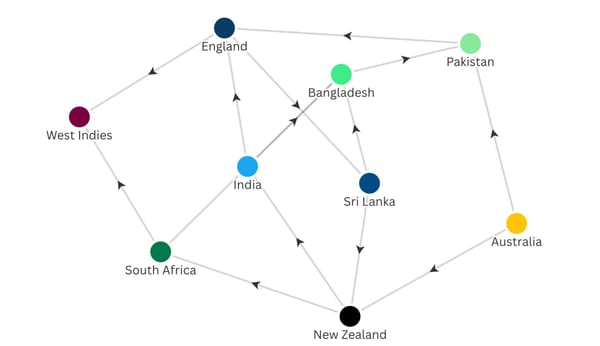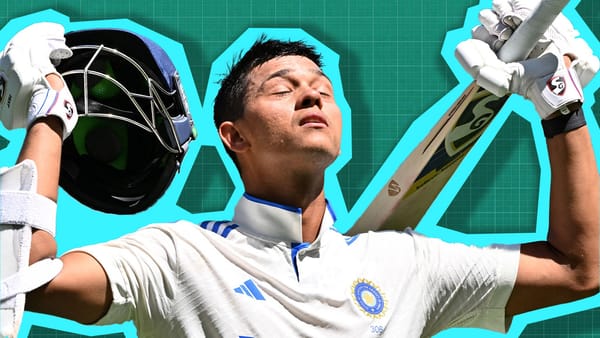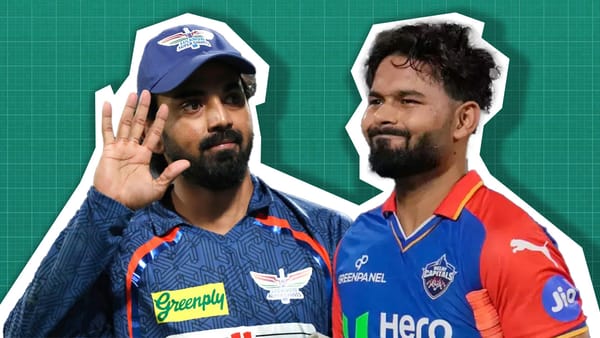England's war on line and length
We have no idea whether England's new theory will work.
Sam Billings moves across his crease, to a Mohammad Siraj ball that will hit the off bail. Billings isn't that interested in the line or length, because his movement starts before the ball is delivered. He makes his first movement before it leaves the hand. By the time the ball is on its way, so is Billings. He knows what kind of line and length he will receive, so he moves over to the off side to pop the ball back over his shoulder.

The more I think about Bazball and England's new method of white-ball batting with the red pill, the more I am left with this one central theoretical question. What is Test cricket without a line and length you can trust?
Whether it be spin or pace, most bowlers have a natural line and length, generally that comes from their home conditions. But these are usually just slight variations on how the game has evolved at any one point. The other major part of it is era.

If you started bowling the ball in the late 1800s, chances are you would have bowled really straight at the stumps. The pitches were poor because liquid manure was only just spreading through the gamed so it made sense to bowl at the stumps.
But then players like Victor Trumper and Ranji started opening up the leg side by intentionally hitting the ball there. Trumper used better pitches to play across the line, and bowlers adjusted over generations to bowl in the corridor outside off stump.
At the same time, bowlers were now swinging the ball much better, meaning the length had to be fuller. Two things changed that. The first was probably cricket going from a back-foot no-ball law to the front foot. Bowlers no longer got as low, as there was no reason to slide into the crease. And that led to taller bowlers, who naturally find it harder to swing the ball, so they bowled shorter.
Then Hawkeye and DRS showed us that bowling short wasn't a good idea, because the stumps are far shorter than we believe. So the length went up, but the line actually changed as well. Umpires now understood that not all balls were sliding down the leg side. And with the advent of the wobble ball a delivery that is aimed at the top of off stump as much as possible.
So most bowlers tend to fit into their era, which is we get fewer pitch up swing bowlers who come close to the stumps than we did in the 80s. And when bowlers don't fit into their era, they often struggle to play.
I think the most extreme is Ryan Harris. He start his career with South Australia in 2001. He was genuinely quick, very smart, and could move the ball around. And yet he never bowled more than 150 overs in a year over those first six seasons.

In Adelaide, he would dominate grade cricket, and people said the reason he didn't take more wickets bowling full was that he was bowling a club length in first class level. In 2007/08 he bowled the same length, and took 37 wickets at 29. It was clear from his bowling that year that he was the best seamer in the country.
From there it took a couple of years for Australia to agree, then from 2010 to 2016 he had the world's third-best average of Test bowlers.

And I wonder how much of his career being so slow was simply that he didn't look like he fit in.
England’s current batting doesn’t quite fit in either. By design. Having almost given up on finding fully functioning consistent Test batters they have decided to smack the hell out of the ball. And while this might seem like a wacky plan that can't possibly work consistently or on most Test surfaces, the idea still has some logic to it. And they were at their lowest moments.
This makes sense, the West Indies changed cricket on the back of two events. Dennis Lillee and Jeff Thomson tormented them with quick bowling, and India chasing 406 at Port of Spain.

Clive Lloyd's plan was to move on from spin bowling - outside of part-timers - slow the over rates down, and use his quicks to dominate teams.
The West Indian team used to have a lot of spinners. Until that point, I would argue that they were a spin nation. Three of their top five bowlers were spinners, and Sobers was a mixture bowler.

In the new book Crickonomics, they talk about how Australia were already number one in the world. Still, they were frustrated they kept drawing games. In the book it talks about how this led to them scoring far quicker.

What is spoken of less is just how attacking Steve Waugh would be with his fields. He would jam the slip cordon even as batters were scoring freely, believing the mistake would eventually come.
These were both risky strategies, Australia could have lost what they had built and the West Indies could have rued never having a spinner. Both went against the thinking at the time, but worked out pretty well. Ofcourse there are probably hundreds of times when teams did something similar and it didn't work. But those are losers, and their stories are often lost to time.
The other thing both the West Indies and Australia did was back their strengths.
That is what England is trying to do. They are producing the best line of consistent hitters cricket has seen. West Indies’ players might still have them for power. But for the ability to hit boundary after boundary, England completely runs the table on that. Why not try it?
You can already see the flaws of this method with Jasprit Bumrah bowling more Yorkers in a spell than New Zealand did in their entire summer. Mohammad Shami was getting the ball to move in both directions at an excellent pace, and spit off the wicket. And because of how well they bowled, Rishabh Pant and Broad's over to Bumrah, India actually scored quicker in the first innings.
Although, it wasn’t for lack of trying. Even when Bairstow was not scoring at all, you could see his white-ball intent right there, but he couldn’t get close enough to the ball to make it count. Even Joe Root was throwing his bat around at the wide balls.
And then, as often happened in this English summer - thanks to the Dukes' balls quality taking a hit during Covid - when the ball got old, Bairstow and Stokes went for it.
Their methods are very different. Stokes comes down the wicket or uses a flat bat. Sometimes both.

Bairstow drives in the air from a length and flicks viciously to the leg side. But they both do the same thing. They are attacking the length bowlers want to land it.
If you are landing the ball at six metres just outside off stump, and Stokes is two metres down the wicket, and outside the line, you've gone from bowling a good length at off stump to a full one on the legs. The problem with Stokes method is that when he comes down, the wicket bowlers see it. So they bowl short, and Stokes is now on the move trying to flat bat a seam bowler, which is a low percentage shot. This summer we have seen him hit this onto his stumps, straight up in the air and find mid off or mid on.
Ben Stokes caught out there because of his method of treating Shardul Thakur like he is Jarvo.
— Jarrod Kimber (@ajarrodkimber) 10:30 AM ∙ Jul 3, 2022
Why he was trying this against Shardul Thakur is also bizarre because for all the brains he possesses as a bowler, he can struggle with line and length. He's the most expensive bowler in the IPL over the last three years at over nine an over.
And so for Stokes, he was playing a low percentage game when he probably didn't need too. His normal level of attacking was probably going to keep Thakur under pressure.
Let's compare that to Bairstow's method.
If you bowl six consecutive balls at the top of off stump. And he plans to attack all of them. If there is any help in the wicket, the chances are he will miss two. And of the others he will probably check his shot or mishit a couple as he adjusts to the ball. Now, because he is such a good and consistence striker he is likely to middle two. Being that he is trying to hit them in the air, they will go over any fielders in a standard Test ring. And because of his power, eight runs is the minimum he can score off these balls.
Now you as the bowler or fielding captain have a decision to make. Before it was pretty easy, you would probably stick with your bowler or field for two or three overs. Because you wouldn't back him to consistently keep hitting. But he can. The first half of this innings where he had to start twice, was somehow not bowled by Shami playing aggressive drives that never really got close to making contact he scored very slow.

Once he got going, he was scoring at nine runs an over by simply attacking balls that most Test batters would not be lofting.
What do you do when a player weaponises your best ball? New Zealand tried to bounce him, some of those balls still haven't landed from Nottingham. India only bowled two overs of spin, so there is always a chance that hitting Jadeja - which Bairstow has never really managed in ODIs - is a way forward. But you still have to bowl your pace.
Test cricket has always been about line and length. The white ball game has far more variation on that. But in Tests, you run up and hit the spot. What do you do when the spot you are trying to hit is now the one that someone hits you from six on?
I think above everything else, the intent, good vibes and freedom, is what England are trying to do. They are going to war with line and length. We have seen it from Root, Stokes, Bairstow and now Billings.
Go back and look at this ball from Mohammad Siraj.

It is a good line and length, we have seen him zip these balls back and take many LBWs in his short career. He is a fairly quick bowler, with good control and a wicked three-quarter seam wobble. And when he bowls a good Test delivery, Sam Billings scoops it.
The chances are this won't work long term or consistently. But this is what England does best, hit hard. They might not win this was, but they were losing before anyway.




